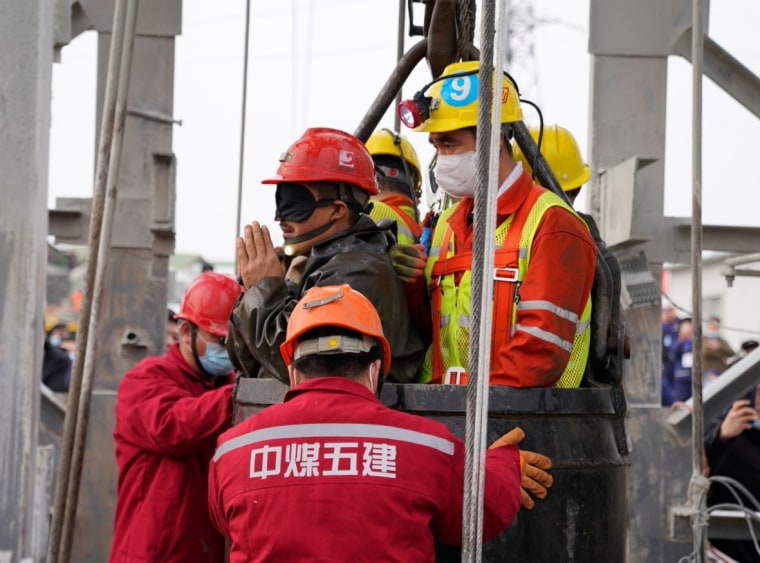Some brought their hands together in gratitude and many appeared almost too weak to stand.

Rescue workers help a miner as he is brought to the surface at the Hushan gold mine on Sunday.
STRINGER / Reuters
Jan. 24, 2021
By The Associated Press
BEIJING — Eleven workers trapped for two weeks inside a Chinese gold mine were brought safely to the surface on Sunday, a landmark achievement for an industry long-blighted by disasters and high death tolls.
State broadcaster CCTV showed workers being hauled up one-by-one in baskets on Sunday afternoon, their eyes shielded to protect them after so many days in darkness.
Some brought their hands together in gratitude and many appeared almost too weak to stand. They were swiftly covered in coats amid freezing temperatures and loaded into ambulances.
Hundreds of rescue workers and officials stood at attention and applauded as the workers were brought up from the mine in Qixia, a jurisdiction under Yantai in the eastern coastal province of Shandong.
One worker was reported to have died from a head wound following the explosion that deposited massive amounts of rubble in the shaft on Jan. 10 while the mine was still under construction.
The fate of 10 others who were underground at the time is unknown. Authorities have detained mine managers for delaying reporting the accident.
The cause of the accident is under investigation but the explosion was large enough to release 70 tons of debris that blocked the shaft, disabling elevators and trapping workers underground.
Jan. 24, 2021
By The Associated Press
BEIJING — Eleven workers trapped for two weeks inside a Chinese gold mine were brought safely to the surface on Sunday, a landmark achievement for an industry long-blighted by disasters and high death tolls.
State broadcaster CCTV showed workers being hauled up one-by-one in baskets on Sunday afternoon, their eyes shielded to protect them after so many days in darkness.
Some brought their hands together in gratitude and many appeared almost too weak to stand. They were swiftly covered in coats amid freezing temperatures and loaded into ambulances.
Hundreds of rescue workers and officials stood at attention and applauded as the workers were brought up from the mine in Qixia, a jurisdiction under Yantai in the eastern coastal province of Shandong.
One worker was reported to have died from a head wound following the explosion that deposited massive amounts of rubble in the shaft on Jan. 10 while the mine was still under construction.
The fate of 10 others who were underground at the time is unknown. Authorities have detained mine managers for delaying reporting the accident.
The cause of the accident is under investigation but the explosion was large enough to release 70 tons of debris that blocked the shaft, disabling elevators and trapping workers underground.
Rescuers drilled parallel shafts to send down food and nutrients and eventually bring up the survivors, 10 of whom had been in a lower chamber and one in a separate area slightly closer to the surface.
The official China Daily newspaper said on its website that seven of the workers were able to walk to ambulances on their own.
Such protracted and expensive rescue efforts are relatively new in China's mining industry, which used to average 5,000 deaths per year. Increased supervision has improved safety, although demand for coal and precious metals continues to prompt corner-cutting.
A new crackdown was ordered after two accidents in mountainous southwestern Chongqing last year killed 39 miners.
The Associated Press



No comments:
Post a Comment